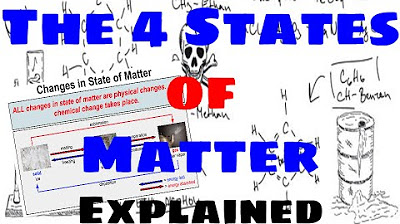Organic Biochemistry Screencast Session 1.mp4
Summary
TLDRIn this educational video, Mr. Gailes introduces the chemistry of life, focusing on organic chemistry's role in biology. He emphasizes the significance of the carbon atom due to its tetravalence, allowing it to form complex molecules essential for life. The video explores various organic molecules like DNA, proteins, and carbohydrates, highlighting how functional groups add diversity and functionality. Mr. Gailes also discusses the historical view of organic chemistry and its distinction from inorganic chemistry, concluding with a look at key functional groups and their impact on molecular properties.
Takeaways
- 🧬 The chemistry of life is rooted in organic chemistry, which focuses on molecules associated with living organisms, most notably DNA.
- 📚 Students are encouraged to take notes using a two-column format, with main ideas on the left and key concepts, definitions, and examples on the right.
- 🌿 All living organisms, despite their diversity, share a common organic biochemistry, highlighting their evolutionary connection.
- ⚛️ Organic chemistry is centered around carbon, an element crucial for building the complex molecules that sustain life.
- 🔗 Carbon's valence of four allows it to form four covalent bonds, a key feature that enables the creation of large and diverse organic molecules.
- 🌟 The ability of carbon to form multiple bonds means it can store and release significant amounts of energy, which is vital for life processes.
- 🔑 Functional groups are essential in adding diversity and functionality to organic molecules, determining their chemical properties and roles in living organisms.
- 💧 Hydroxy, carbonyl, carboxy, phosphate, and amino groups are among the key functional groups that influence an organic molecule's polarity and solubility.
- 🧪 The study of organic chemistry in biology is not only about understanding the structure of life but also the functional aspects that enable biological processes.
- 🤔 Students are prompted to record questions that arise during the presentation, fostering an interactive and inquiry-based learning approach.
Q & A
What is the most recognizable organic molecule associated with life?
-The most recognizable organic molecule associated with life is the DNA molecule, which is used by all living things to store their genetic blueprint.
What is the significance of the two-column note format mentioned in the script?
-The two-column note format is a method for organizing notes with main ideas on the left and key ideas, definitions, examples, and drawings on the right, which aids in studying and reviewing the material.
Why is organic chemistry important in the study of biology?
-Organic chemistry is important in the study of biology because it focuses on the chemistry of life, specifically the molecular organic chemistry that underpins the functions and structures of all living organisms.
What role does the carbon atom play in building organic molecules?
-The carbon atom is central to building organic molecules due to its tetravalence, allowing it to form four covalent bonds, which is essential for creating the large and diverse molecules found in living organisms.
How does the carbon atom's ability to form many bonds relate to energy storage and release in living organisms?
-The carbon atom's ability to form many bonds allows it to store and release energy. When bonds form, potential energy is stored, and when they break, that energy is released and can be used by cells to perform work.
What is a functional group and how does it contribute to the diversity of organic molecules?
-A functional group is a group of atoms that can bond to a carbon skeleton, determining the properties and functions of organic molecules. The addition of different functional groups to a carbon backbone creates diverse molecules with specific roles in living organisms.
Why are organic molecules generally associated with living things?
-Organic molecules are generally associated with living things because they are typically made by living organisms or are directly related to the functions of living things, unlike inorganic chemicals that are generally associated with the environment.
What are the six key elements of life in organic chemistry?
-The six key elements of life in organic chemistry are carbon, hydrogen, nitrogen, oxygen, phosphorus, and sulfur.
How does the structure of carbon allow it to form such a variety of bonds?
-Carbon's structure allows it to form a variety of bonds due to having four valence electrons, which it can share, lose, or gain to form single, double, or triple bonds with other atoms, including other carbon atoms.
What is the role of the phosphate group in organic molecules?
-The phosphate group is found in lipids, forming the polar head of phospholipids which are components of cell membranes, and in nucleic acids, where it forms the backbone along with sugar molecules. It is also part of adenosine triphosphate (ATP), the cellular energy source.
How does the addition of functional groups affect the properties of organic molecules?
-The addition of functional groups to a carbon skeleton affects the properties of organic molecules by imparting polarity and hydrophilicity, which determines how they interact with water and other molecules, thus influencing their functions in living organisms.
Outlines

هذا القسم متوفر فقط للمشتركين. يرجى الترقية للوصول إلى هذه الميزة.
قم بالترقية الآنMindmap

هذا القسم متوفر فقط للمشتركين. يرجى الترقية للوصول إلى هذه الميزة.
قم بالترقية الآنKeywords

هذا القسم متوفر فقط للمشتركين. يرجى الترقية للوصول إلى هذه الميزة.
قم بالترقية الآنHighlights

هذا القسم متوفر فقط للمشتركين. يرجى الترقية للوصول إلى هذه الميزة.
قم بالترقية الآنTranscripts

هذا القسم متوفر فقط للمشتركين. يرجى الترقية للوصول إلى هذه الميزة.
قم بالترقية الآنتصفح المزيد من مقاطع الفيديو ذات الصلة

The Four States of Matter - Explained

Lab Equipment - Explained

3. Gr 11 Life Sciences - Population Ecology - Theory 3 Mark Recapture Method

4. Gr 11 Life Sciences - Population Ecology - Worksheet 1

PENJASKES KELAS X - SOFTBALL

Introduction to Culture [AP Human Geography Review Unit 3 Topic 1]

Menentukan Mr ( massa molekul relatif )
5.0 / 5 (0 votes)
